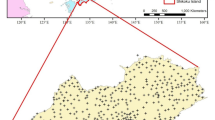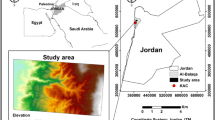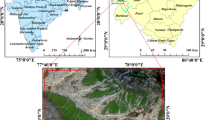Abstract
The digital elevation model (DEM), a quantitative depiction of the topography, is crucial for hydrological and Earth Science applications. It is essential to assess the precision of the parameters obtained from the various DEMs available for morphometric study of the catchment region and extraction of the elevation. The accuracy of these datasets, which varies from one dataset to the next, is not always evident. We evaluated DEMs from the Shuttle Radar Topography Mission (SRTM), Advanced Spaceborne Thermal Emission and Reflection Radiometer (ASTER), and CARTOSAT in terms of vertical accuracy, morphometric characteristics, and longitudinal river profile. The investigation was conducted in the Himalayan basin-Lohawati, in the Eastern Kumaon region of Uttarakhand, India. The SRTM performance was found to be more accurate than the ASTER and CARTOSAT DEMs in terms of overall vertical accuracy, as measured by mean absolute error, mean bias error, root-mean-square error, normalized root-mean-square error, relative root-mean-square error, and Nash–Sutcliffe Efficiency. The morphometric analysis revealed that the basin was elongated with a low relief ratio, gentle slopes, and low drainage density. The results from various DEM sources were comparable, indicating that the majority of morphometric parameters were not significantly scale- and source-dependent. SRTM and ASTER DEMs produced better results than CARTOSAT DEM, as demonstrated by the longitudinal river profile. Researchers employing such products in a variety of modelling exercises may find these results to be extremely useful. However, the findings of this study must be evaluated and validated across a broader range of geographies and lithologies.














Similar content being viewed by others
Data availability
The majority of the data utilized in this study can be obtained without cost from several online databases. Data tiles for both the ASTER GDEM and SRTM DEM were obtained for free from the USGS Earth Explorer repository. The CartoDEM tiles originated from ISRO's Geo-Platform, Bhuvan, which provides open access to a variety of geospatial datasets. The remaining data used are available within the manuscript in the form of tables.
References
Abdi I (2018) Vertical accuracy assessment of open source digital elevation model using GPS points reference DEM over Ethiopia a case study in Addis Ababa and Dire Dawa (MSc thesis). AAU, Ethiopia
Abili HZ (2021) Comparison of vertical accuracy of open-source global digital elevation models: a case study of Adama City, Ethiopia. Turk J Comp Math Edu (TURCOMAT) 12(4):1731–1744. https://doi.org/10.17762/turcomat.v12i4.1437
Abrams M, Hook S (2002) ASTER user handbook version 2. Jet Propulsio, vol 2003. Abrams2002NASA.pdf
Agarwal R, Sur K, Rajawat AS (2020) Accuracy assessment of the CARTOSAT DEM using robust statistical measures. Model Earth Syst Environ 6(1):471–478. https://doi.org/10.1007/s40808-019-00694-9
Altaf F, Meraj G, Romshoo SA (2013) Morphometric analysis to infer hydrological behaviour of Lidder watershed, Western Himalaya. India Geogr J. https://doi.org/10.1155/2013/178021
Asthana AKL, Gupta AK, Luirei K, Bartarya SK, Rai SK, Tiwari SK (2015) A quantitative analysis of the Ramganga drainage basin and structural control on drainage pattern in the fault zones, Uttarakhand. J Geol Soc India 86(1):9–22. https://doi.org/10.1007/s12594-015-0276-6
Azizian A, Brocca L (2020) Determining the best remotely sensed DEM for flood inundation map** in data sparse regions. Int J Remote Sens 41(5):1884–1906. https://doi.org/10.1080/01431161.2019.1677968
Banerjee A, Singh P, Pratap K (2017) Morphometric evaluation of Swarnrekha watershed, Madhya Pradesh, India: an integrated GIS-based approach. Appl Water Sci 7(4):1807–1815. https://doi.org/10.1007/s13201-015-0354-3
Chai LT, Wong CJ, James D, Loh HY, Liew JJF, Wong WVC, Phua MH (2022) Vertical accuracy comparison of multi-source Digital Elevation Model (DEM) with Airborne Light Detection and Ranging (LiDAR). IOP Conf Ser Earth Environ Sci 053(1):012025. https://doi.org/10.1088/1755-1315/1053/1/012025
Chymyrov A (2021) Comparison of different DEMs for hydrological studies in the mountainous areas. Egypt J Remote Sens Space Sci 24(3):587–594. https://doi.org/10.1016/j.ejrs.2021.08.001
Clubb FJ, Mudd SM, Attal M, Milodowski DT, Grieve SWD (2016) The relationship between drainage density, erosion rate, and hilltop curvature: implications for sediment transport processes. J Geophys Res Earth Surf 121:1724–1745. https://doi.org/10.1002/2015JF003747
Congalton RG, Green K (2009) Assessing the accuracy of remotely sensed data—principles and practices, 2nd edn. CRC Press, Boca Raton
Das AK, Mukherjee S (2005) Drainage morphometry using satellite data and GIS in Raigad district, Maharashtra. J Geol Soc India 65:577–586
Dar RA, Chandra R, Romshoo SA (2013) Morphotectonic and lithostratigraphic analysis of intermontane Karewa basin of Kashmir Himalayas, India. J Mt Sci 10(1):1–15. https://doi.org/10.1007/s11629-013-2494-y
Das S, Patel PP, Sengupta S (2016) Evaluation of different digital elevation models for analyzing drainage morphometric parameters in a mountainous terrain: a case study of the Supin-Upper Tons Basin, Indian Himalayas. Springerplus 5(1):1–38. https://doi.org/10.1186/s40064-016-3207-0
del Rosario Gonzalez-Moradas M, Viveen W (2020) Evaluation of ASTER GDEM2, SRTMv3.0, ALOS AW3D30 and TanDEM-X DEMs for the Peruvian Andes against highly accurate GNSS ground control points and geomorphological-hydrological metrics. Remote Sens Environ 237:111509. https://doi.org/10.1016/j.rse.2019.111509
Elkhrachy I (2018) Vertical accuracy assessment for SRTM and ASTER digital elevation models: a case study of Najran city. Saudi Arabia Ain Shams Eng J 9(4):1807–1817. https://doi.org/10.1016/j.asej.2017.01.007
Faniran A (1968) The index of drainage intensity: a provisional new drainage factor. Aus J Sci 31(9):326–330
Farr TG, Rosen PA, Caro E, Crippen R et al (2007) The shuttle radar topography mission. Rev Geophys. https://doi.org/10.1029/2005RG000183
Ferreira ZA, Cabral P (2022) A Comparative study about vertical accuracy of four freely available digital elevation models: a case study in the Balsas river watershed, Brazil. ISPRS Int J Geo-Inf 11(2):106. https://doi.org/10.3390/ijgi11020106
Fisher PF, Tate NJ (2006) Causes and consequences of error in digital elevation models. Prog Phys Geogr 30(4):467–489. https://doi.org/10.1191/0309133306pp492ra
Ganie PA, Posti R, Kumar P, Singh A (2016) Morphometric analysis of a Kosi River Basin, Uttarakhand using geographical information system. Int J Multidiscip Curr Res 4:1190–1200
Ganie PA, Posti R, Kunal K, Kunal G, Sarma D, Pandey PK (2022) Insights into the morphometric characteristics of the Himalayan River using remote sensing and GIS techniques: a case study of Saryu basin, Uttarakhand, India. Appl Geomat. https://doi.org/10.1007/s12518-022-00461-z
Giribabu D, Kumar P, Mathew J, Sharma KP, Murthy YK (2013) DEM generation using Cartosat-1 stereo data: issues and complexities in Himalayan terrain. Eur J Remote Sen 46(1):431–443. https://doi.org/10.5721/EuJRS20134625
Gorokhovich Y, Voustianiouk A (2006) Accuracy assessment of the processed SRTM-based elevation data by CGIAR using field data from USA and Thailand and its relation to the terrain characteristics. Remote Sen Environ 104(4):409–415. https://doi.org/10.1016/j.rse.2006.05.012
Gregory KJ, Walling DE (1973) Drainage basin form and process a geomorphological approach. Edward Arnold, London, p 456
Gröger G, Kolbe TH, Nagel C, Häfele KH (2012) OGC city geography markup language (CityGML) encoding standard
Hadley RF, Schumm SA (1961) Sediment sources and drainage basin characteristics in upper Cheyenne River basin. USGS water supply paper, 1531-B
Hengl T, Evans IS (2009) Mathematical and digital models of the land surface. Dev Soil Sci 33:31–63. https://doi.org/10.1016/S0166-2481(08)00002-0
Hoover Mackin J (1948) Concept of the graded river. Geol Soc Am Bull 59(5):463–512. https://doi.org/10.1130/0016-7606(1948)59[463:COTGR]2.0.CO;2
Horton RE (1945) Erosional development of streams and their drainage basins: hydro-physical approach to quantitative morphology. Geol Soc Am Bull 56:275–370. https://doi.org/10.1130/0016-7606(1945)56[275:EDOSAT]2.0.CO;2
IMD (2022) Indian meteorological department https://mausam.imd.gov.in/imd_latest/contents/climate_services_daily_rainfall_maps.php. Accessed 25 Sep 2022
Jenson SK, Domingue JO (1988) Extracting topographic structure from digital elevation data for geographic information system analysis. Photogramm Eng Remote Sensing 54(11):1593–1600
Kamal HM, El-Molla AM, Ahmed HG, Mohamed MH, Saleh SS (2017) Accuracy assessment of SRTM and ASTER DEMs over Egypt. Int J Sci Eng Res 8(11)
Kaplan D, Hegarty CJ (2006) Understanding GPS: principles and applications. Artech House, Boston, p 32
Kasi V, Pinninti R, Landa SR, Rathinasamy M, Sangamreddi C, Kuppili RR, Dandu Radha PR (2020) Comparison of different digital elevation models for drainage morphometric parameters: a case study from South India. Arab J Geosci 13(19):1–17. https://doi.org/10.1007/s12517-020-06049-4
Kobrick M (2006) On the toes of giants-How SRTM was born. Photogramm Eng Remote Sens 72(3):206–210
Kroll CN, Stedinger JR (1996) Estimation of moments and quantiles using censored data. Water Resour Res 32(4):1005-1012. https://doi.org/10.1029/95WR03294
Lin Z, Oguchi T (2006) DEM analysis on longitudinal and transverse profiles of steep mountainous watersheds. Geomorphol 78(1–2):77–89. https://doi.org/10.1016/j.geomorph.2006.01.017
Maune DF (2007) DEM user applications. In: Maune DF, Nayegandhi A (eds) Digital elevation model: technologies and applications: the DEM user’s manual, 3rd edn. Asprs Publications, Baton Rouge
McCuen RH, Knight Z, Cutter AG (2006) Evaluation of the Nash-Sutcliffe efficiency index. J Hydrol Eng 11(6):597–602. https://doi.org/10.1061/(ASCE)1084-0699(2006)11:6(597)
Miller V (1953) A quantitative geomorphic study of drainage basin characteristics in the Clinch Mountain Area, Virginia and Tennessee. Project NR 389-402, Technical Report 3, Columbia University, Department of Geology, ONR, New York
Mukherjee S, Joshi PK, Mukherjee S, Ghosh A, Garg RD, Mukhopadhyay A (2013) Evaluation of vertical accuracy of open source Digital Elevation Model (DEM). Int J Appl Earth Obs Geoinf 21:205–217. https://doi.org/10.1016/j.jag.2012.09.004
Mustak SK, Baghmar NK, Ratre CR (2012) Measurement of dissection index of Pairi river basin using remote sensing and GIS. Natl Geogr J India 58(2):97–106
Nash JE, Sutcliffe JV (1970) River flow forecasting through conceptual model. Part 1—A discussion of principles. J Hydrol 10:282–290. https://doi.org/10.1016/0022-1694(70)90255-6
Nelson A, Reuter HI, Gessler P (2009) DEM production methods and sources. In: Hengl T, Reuter HI (eds) Geomorphometry: concepts, software, applications, developments in soil science, vol 33. Elsevier, Amsterdam, pp 65–85
Nikolakopoulos KG, Kamaratakis EK, Chrysoulakis N (2006) SRTM vs ASTER elevation products. Comparison for two regions in Crete, Greece. Int J Remote Sens 27(21): 4819–4838. https://doi.org/10.1080/01431160600835853
Nuth C, Kääb A (2011) Co-registration and bias corrections of satellite elevation data sets for quantifying glacier thickness change. Cryosphere 5(1):271–290. https://doi.org/10.5194/tc-5-271-2011
Pophare AM, Balpande US (2014) Morphometric analysis of Suketi river basin, Himachal Himalaya, India. J Earth Syst Sci 123(7):1501–1515. https://doi.org/10.1007/s12040-014-0487-z
Prabhakaran A, Jawahar Raj N (2018) Map** and analysis of tectonic lineaments of Pachamalai hills, Tamil Nadu, India using geospatial technology. Geol Ecol Landsc 2(2):81–103. https://doi.org/10.1080/24749508.2018.1452481
Rai PK, Mohan K, Mishra S, Ahmad A, Mishra VN (2017) A GIS-based approach in drainage morphometric analysis of Kanhar River Basin. India Appl Water Sci 7(1):217–232. https://doi.org/10.1007/s13201-014-0238-y
Rawat KS, Singh SK, Singh MI, Garg BL (2019) Comparative evaluation of vertical accuracy of elevated points with ground control points from ASTERDEM and SRTMDEM with respect to CARTOSAT-1DEM. Remote Sens Appl Soc Environ 13:289–297. https://doi.org/10.1016/j.rsase.2018.11.005
Romshoo SA, Yousuf A, Altaf S, Amin M (2021) Evaluation of various DEMs for quantifying soil erosion under changing land use and land cover in the Himalaya. Front Earth Sci 9:782128. https://doi.org/10.3389/feart.2021.782128
Saran S, Sterk G, Peters P, Dadhwal VK (2010) Evaluation of digital elevation models for delineation of hydrological response units in a Himalayan watershed. Geocarto Int 25(2):105–122. https://doi.org/10.1080/10106040903051967
Satgé F, Bonnet MP, Timouk F, Calmant S, Pillco R, Molina J, Lavado-Casimiro W, Arsen A, Crétaux JF, Garnier J (2015) Accuracy assessment of SRTM v4 and ASTER GDEM v2 over the Altiplano watershed using ICESat/GLAS data. Int J Remote Sen 36(2):465–488. https://doi.org/10.1080/01431161.2014.999166
Schumm SA (1956) Evolution of drainage systems & slopes in badlands at Perth, New Jersey. Bull Geol Soc Am 67:597–646. https://doi.org/10.1130/0016-7606(1956)67[597:EODSAS]2.0.CO;2
Selvan MT, Ahmad S, Rashid SM (2011) Analysis of the geomorphometric parameters in high altitude glacierized terrain using SRTM DEM data in Central Himalaya, India. ARPN J Eng Appl Sci 1(1):22–27
Shetty S, Vaishnavi PC, Umesh P, Shetty A (2022) Vertical accuracy assessment of open source digital elevation models under varying elevation and land cover in Western Ghats of India. Model Earth Syst Environ 8:883–895. https://doi.org/10.1007/s40808-021-01119-2
Shortridge A, Messina J (2011) Spatial structure and landscape association of SRTM error. Remote Sens Environ 115:1576–1587. https://doi.org/10.1016/j.rse.2011.02.017
Shreve RL (1966) Statistical law of stream numbers. The J Geol 74(1):17–37. https://doi.org/10.1086/627137
Snow RS, Slingerland RL (1987) Mathematical modeling of graded river profiles. J Geol 95(1): 15–33. https://www.jstor.org/stable/30081066
Strahler AN (1952) Dynamic basis of geomorphology. Geol Soc Am Bull 63(9):923–938. https://doi.org/10.1130/0016-7606(1952)63[923:DBOG]2.0.CO;2
Strahler AN (1958) Quantitative geomorphology of drainage basins and channel networks. In: Chow VT (ed) Handbook of applied hydrology, McGraw Hill, New York, pp 439–476
Strahler AN (1964) Part II. Quantitative geomorphology of drainage basins and channel networks. Handbook of applied hydrology. McGraw-Hill, New York, pp 4–39
Talchabhadel R, Nakagawa H, Kawaike K, Yamanoi K, Thapa BR (2021) Assessment of vertical accuracy of open source 30m resolution space-borne digital elevation models. Geomatics Nat Hazards and Risk 12(1):939–960. https://doi.org/10.1080/19475705.2021.1910575
Tarboton DG (1997) A new method for the determination of flow directions and contributing areas in grid digital elevation models. Water Resour Res 33:309–319. https://doi.org/10.1029/96WR03137
Tarboton DG, Bras RL, Rodriguez-Iturbe I (1991) On the extraction of channel networks from digital elevation data. Hydroll Process 5:81–100. https://doi.org/10.1002/hyp.3360050107
Thomas J, Prasannakumar V (2015) Comparison of basin morphometry derived from topographic maps, ASTER and SRTM DEMs: an example from Kerala. India Geocarto Int 30(3):346–364. https://doi.org/10.1080/10106049.2014.955063
Tsutsui K, Rokugawa S, Nakagawa H, Miyazaki S, Cheng CT, Shiraishi T, Yang SD (2007) Detection and volume estimation of large-scale landslides based on elevation-change analysis using DEMs extracted from high-resolution satellite stereo imagery. IEEE Trans Geosci Remote Sens 45(6):1681–1696. https://doi.org/10.1109/TGRS.2007.895209
Turowski JM, Lague D, Hovius N (2009) Response of bedrock channel width to tectonic forcing: Insights from a numerical model, theoretical considerations, and comparison with field data. J Geophys Res Earth Surf. https://doi.org/10.1029/2008JF001133
Van Niel TG, McVicar TR, Li L, Gallant JC, Yang Q (2008) The impact of misregistration on SRTM and DEM image differences. Remote Sens Environ 112(5):2430–2442. https://doi.org/10.1016/j.rse.2007.11.003
Varga M, Bašić T (2015) Accuracy validation and comparison of global digital elevation models over Croatia. Int J Remote Sens 36(1):170–189. https://doi.org/10.1080/01431161.2014.994720
Vijith H, Satheesh R (2006) GIS based morphometric analysis of two major upland sub-watersheds of Meenachil river in Kerala. J Indian Soc Remote Sens 34(2):181–185. https://doi.org/10.1007/BF02991823
Viveen W, Schoorl JM, Veldkamp A, van Balen RT, Vidal-Romani JR (2013) Fluvial terraces of the NW iberian lower Mino river. J Maps 9(4):513–522. https://doi.org/10.1080/17445647.2013.821096
Wechsler SP (2007) Uncertainties associated with digital elevation models for hydrologic applications: a review. Hydrol Earth Sys Sci 11(4):1481–1500. https://doi.org/10.5194/hess-11-1481-2007
Willmott CJ (1982) Some comments on the evaluation of model performance. Bull Am Meteorol Soc 63(11):1309–1313. https://www.jstor.org/stable/26222954
Yap L, Kandé LH, Nouayou R, Kamguia J, Ngouh NA, Makuate MB (2019) Vertical accuracy evaluation of freely available latest high-resolution (30 m) global digital elevation models over Cameroon (Central Africa) with GPS/leveling ground control points. Int J Digit Earth 12(5):500–524. https://doi.org/10.1080/17538947.2018.1458163
Zhang K, Gann D, Ross M, Robertson Q, Sarmiento J, Santana S, Rhome J, Fritz C (2019) Accuracy assessment of ASTER, SRTM, ALOS, and TDX DEMs for Hispaniola and implications for map** vulnerability to coastal flooding. Remote Sens Environ 225:290–306. https://doi.org/10.1016/j.rse.2019.02.028
Zhilin L, Qing Z, Gold C (2005) Digital terrain modelling. Principles and methodology. CRC-Press, Boca Raton
Zuchiewicz W (1980) The tectonic interpretation of longitudinal profiles of the Carpathians rivers. Ann Soc Geol Pol 50(3–4):311–328
Acknowledgements
The authors would like to express their gratitude to the Director of ICAR-Directorate of Coldwater Fisheries Research and the Director of ICAR-Central Institute of Fisheries Education, Mumbai, for providing the necessary resources for this study. The information provided by the NRSC, Bhuvan, and the U.S. Geological Survey's earth explorer is greatly appreciated. Sincere thanks are expressed to both Mr. Govind and Mr. Mahesh for their support in the field data collection. The anonymous reviewers are acknowledged for their informative remarks that contributed to the manuscript's improvement.
Author information
Authors and Affiliations
Contributions
PAG: conceptualisation, resources, methodology, data curation, software, writing—original draft, and writing—review and editing. RP: methodology, software, and formal analysis. ASA: analysis, editing, and visualization. VSB: investigation, supervision, and visualization. VKS: investigation, supervision, visualization, and review. DS: supervision and visualization. PKP: supervision visualization, review and editing.
Corresponding author
Ethics declarations
Conflict of interest
The authors declare no competing financial interests or personal relationships that could have appeared to influence the work reported in this paper.
Informed consent
None.
Ethical approval
The authors of this article have not conducted any studies involving human subjects or animals.
Additional information
Publisher's Note
Springer Nature remains neutral with regard to jurisdictional claims in published maps and institutional affiliations.
Supplementary Information
Below is the link to the electronic supplementary material.
Rights and permissions
Springer Nature or its licensor (e.g. a society or other partner) holds exclusive rights to this article under a publishing agreement with the author(s) or other rightsholder(s); author self-archiving of the accepted manuscript version of this article is solely governed by the terms of such publishing agreement and applicable law.
About this article
Cite this article
Ganie, P.A., Posti, R., Aswal, A.S. et al. A comparative analysis of the vertical accuracy of multiple open-source digital elevation models for the mountainous terrain of the north-western Himalaya. Model. Earth Syst. Environ. 9, 2723–2743 (2023). https://doi.org/10.1007/s40808-022-01641-x
Received:
Accepted:
Published:
Issue Date:
DOI: https://doi.org/10.1007/s40808-022-01641-x




